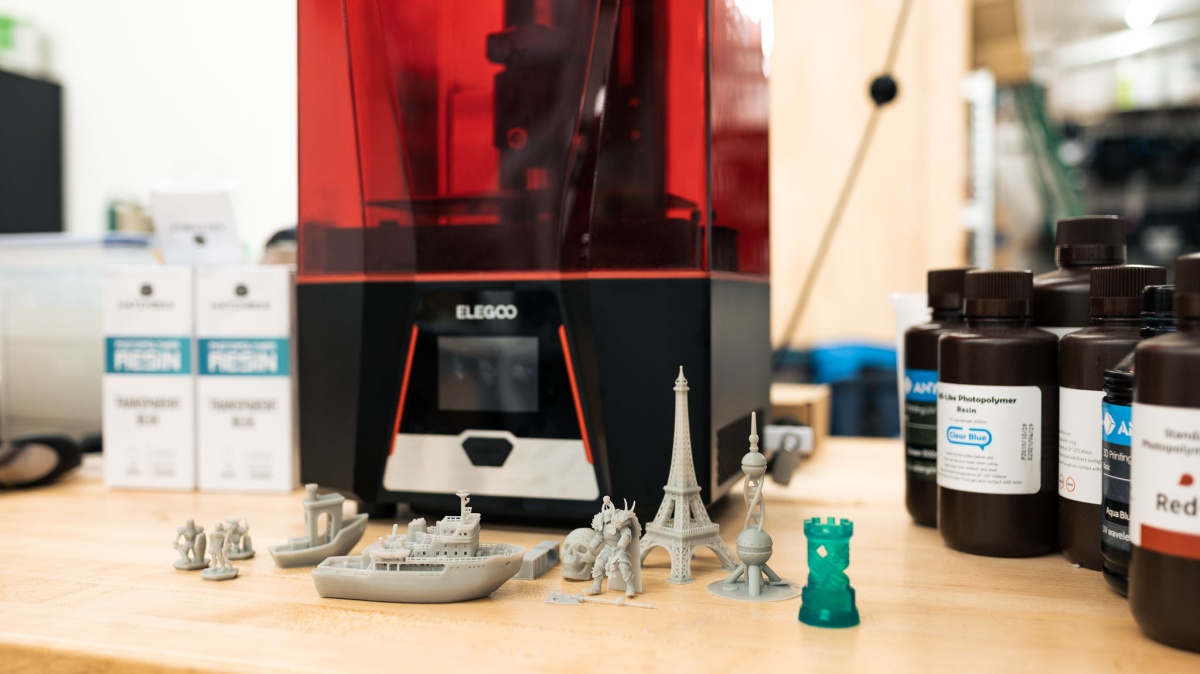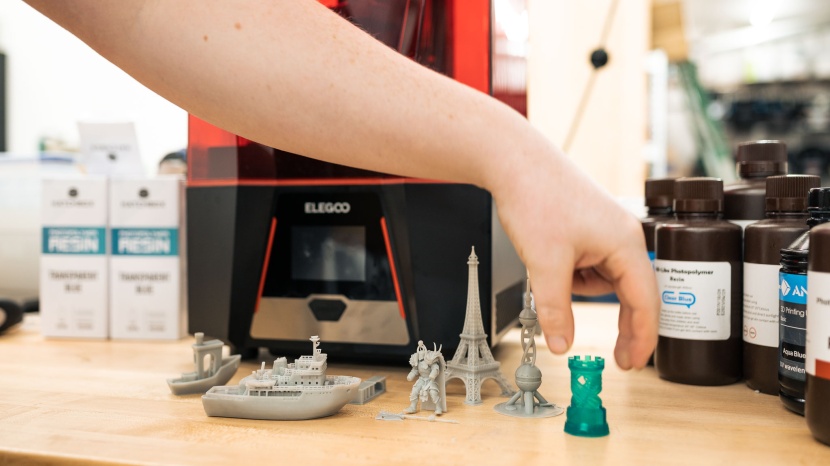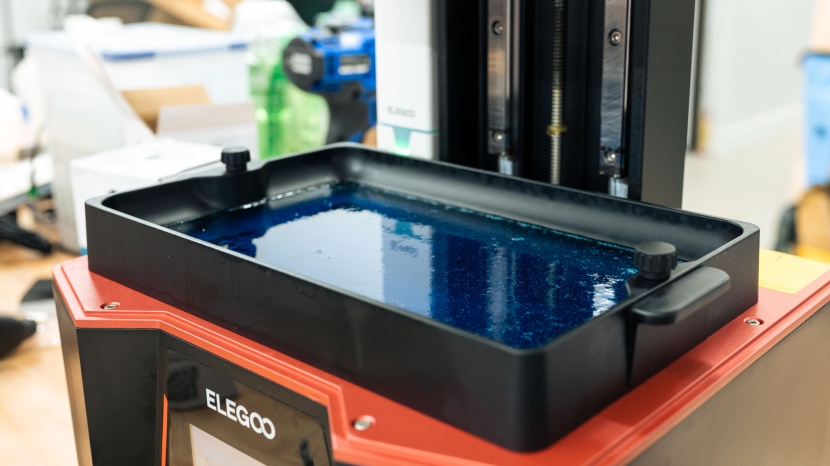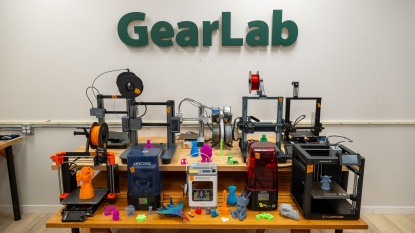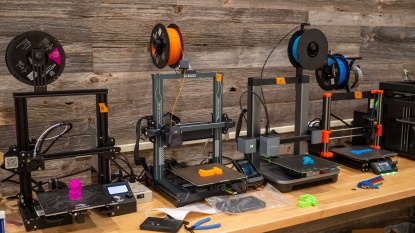Our Verdict
Our Analysis and Test Results
Print Quality
You should know off the bat we gave the Saturn 2 a gold star for our print quality evaluation. Resin and FDM printers are judged by the same criteria and on the same scale in our testing facility, and resin printers simply produce far better detail and overall quality of prints compared with FDM (though FDM generally easily wins the “ease of use” battle, to put it mildly). Its prints are absolutely superb, even with out-of-the-box settings.
Our starting Benchmark tests are really about sussing out minute imperfections that will be obvious in geometrically perfect simple shapes. The walls of the hollow models throughout showed excellent dimensional stability, with only the thinnest walls showing any sort of wave. Our overhang tests give progressively steeper angles to test warp and roughness, and surprisingly only the shallow angles showed anything less than perfect builds, usually the opposite.
Our simple cones and pillars are nearly perfect, though, minus a tiny shift up one of them, which was likely due to a slight bump to the table. The cones in particular came to a consistent, sharp point. That is the difference a resin printer can give you.
Moving to other models, the Eiffel Tower is a particularly useful stress test, and the Saturn 2 gave us an impeccable model. Every crossbeam came out beautifully defined. The tiny chiclet teeth of our skull were clear and impressively detailed, though some of the cavities in the smaller bones did close up. The build layers were essentially undetectable, which is generally the easiest evidence of having been printed for a printer of this quality.
The tiny windows and handrails formed flawlessly in our tugboat test. The leftover resin inside the hull was more difficult than average to drain, but we can hardly complain. We were most impressed by the tiny details in the axe, thin but straight handle, and the delicate tiny horn details of our Nurgle champion also came out as good as we've ever seen. It's the successes in this and the smaller figurines that pushed us over the edge
Ease of Use
Print quality is flat out the most important category for most print enthusiasts, and rightly so. But as good as resin printers are with that, they are a massive PITA to use, and a literal mess. Working with resin is inherently sticky and annoying, it needs to be cleaned and stored for anything longer than a day or so between prints, and the prints require draining and cleaning.
The Saturn 2 resin tank is small (just 700ml), and we noticed it seems to be more viscous than average, meaning draining and cleanup take longer. The good thing here is that we found an unintended feature in that you can remove the build plate and mount it at 90 degrees. Back on the gantry after it finishes to help drain and drip the excess resin easier. The bottom line is to be prepared to wear PPE throughout the process and move slowly to avoid a large mess.
The Saturn 2 does have some bright spots here. Setup out of the box rivals even some FDM printers, which are inherently simpler in the number of moving parts required. The unit arrives nearly ready to go — remove the film from the LCD screen, attach and level the build plate, screw on the resin vat, and plug in the air filter. That's about it. Leveling the plate is also easier than average for a resin printer. It's not automatic, but the layout and screw access makes it easy to get the right tension on the paper shim between the plate and screen, though you'll need to re-level after every print since you need to remove the plate to remove the prints.
One last thing to mention is that your only option to get the print from computer to printer is through a USB thumb drive. No wifi, no SD card slot. Not the worst thing, but we prefer to see at least network connectivity in a printer at this price point.
Print Capabilities
Moving on, the Saturn 2 has some nice features and upgrades from earlier models. Most notable is its 8k resolution LCD screen, double that of the 4k Saturn. Resin printers live and die by their screen resolution and the 10 inch, 8k screen here is largely responsible for stellarbuild quality. Its build volume (219x123x250mm) is squarely in the realm of mid-sized printers, but it's significantly larger than the OG Saturn, particularly in the z-axis (50mm deeper). Print layer resolution is also a very impressive 28.5 micrometers (μm).
The printer's build quality itself is good, but the aluminum build plate is fairly easy to scratch, and the sandblasted texture is pretty aggressive, meaning it can be very difficult to remove prints. It's worth noting if you tend to go for more delicate prints. The resin vat is also pretty shallow, so you may need to refill part way through a larger print.
We are pretty content with the built-in air purifier. It did a mostly adequate job of removing the telltale resin odor, so you can consider bringing it in from the garage or basement and around your work space. Chitubox is the standard slicer to use here, which is good (Lychee is also officially supported). We find Chitubox is the standard of resin printers.
Support
To start, there's a decent lineup of video support and Youtube videos specific to the Saturn 2. They're pretty long and detailed, showing mostly real-time replacements and setup, which we found helpful.
For traditional customer support, their standard service e-mail address is the way to go. We could find no US based phone number. They did get back to us in a few days consistently and were averagely helpful — that is to say they're knowledgeable and helpful but don't bend over backward to be sure you're fully taken care of.
Should You Buy the Elegoo Saturn 2?
For this price point we think this is the best option you're going to have for hyper-detailed prints and a good production rate with the build size. If you can handle the added work a resin printer gives you, this is the best option we've found, bar none.
What Other 3D Printer Should You Consider?
Anycubic's Photon M3 Premium is a nearly carbon copy rival in the resin sphere. We give a slight edge to the Saturn 2 for it's slightly smaller price tag and slightly better print quality, but for all intents and purposes, if you're loyal to Anycubic as a brand, much of the analysis here applies to the M3 as well.
On the easier and less messy FDM side of things, there's a huge selection of great options to choose from. Go for the near-limitless upgradeable Bambu P1P, the affordable all-around great Anycubic Vyper, or the Prusa i3 MK3S+ for the highest quality prints FDM can give.

